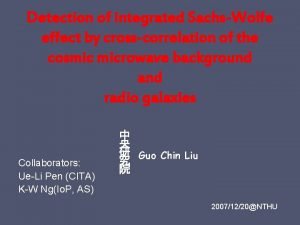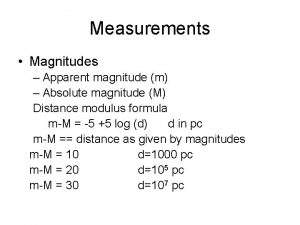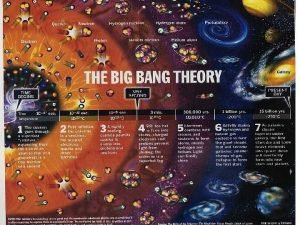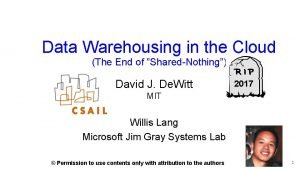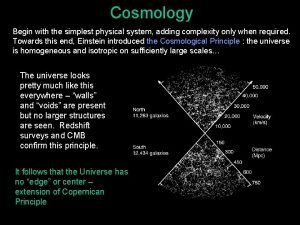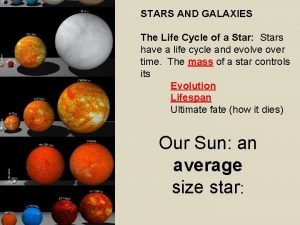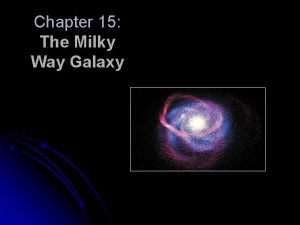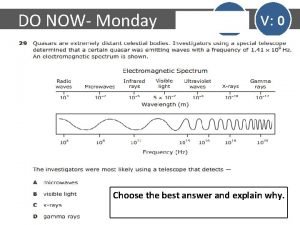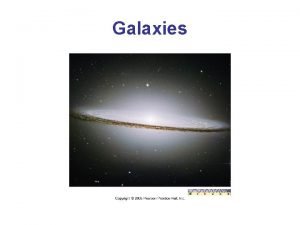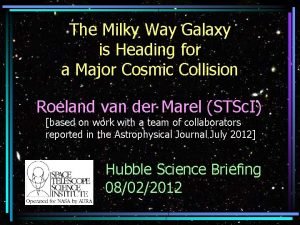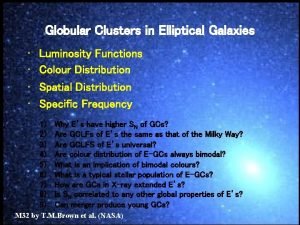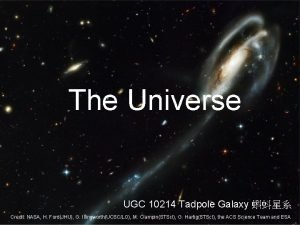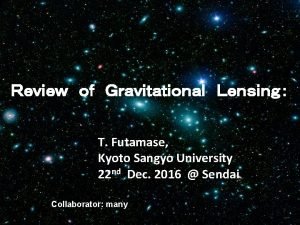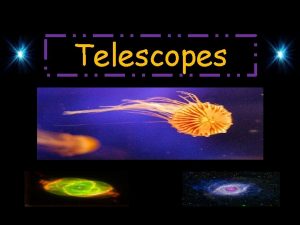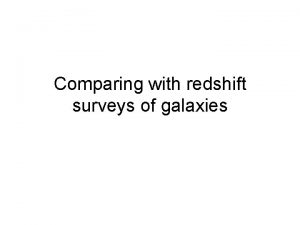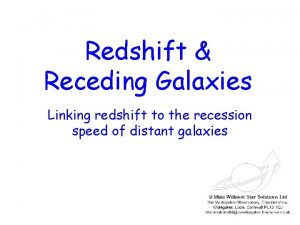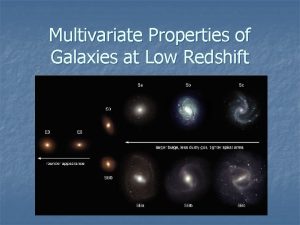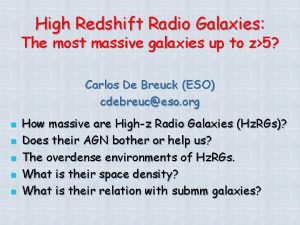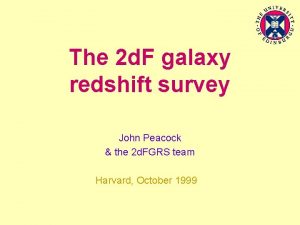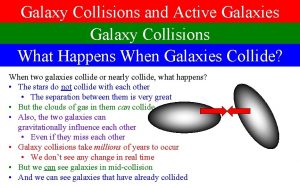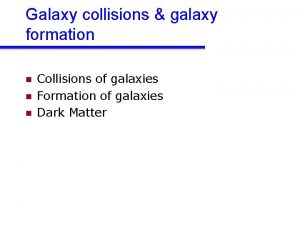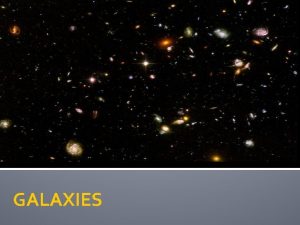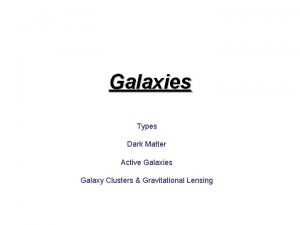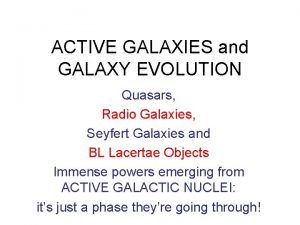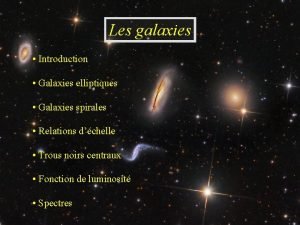2 d F Galaxy Redshift Survey M galaxies





































- Slides: 37

2 d. F Galaxy Redshift Survey ¼ M galaxies 2003 n o iz 4 1/ CFA Survey 1980 of th e r o h

The Initial Fluctuations At Inflation: Gaussian, adiabatic a realization of an ensemble ensembe average ~ volume average fluctuation field Fourier Power Spectrum rms δ Pk k M

Scale-Invariant Spectrum (Harrison-Zel’dovich) mass M time

Cosmological Scales mass teq zeq~104 t 0 time

CDM Power Spectrum mass growth when matter is self-gravitating teq CDM t time Pk HDM free streeming Meq mass CDM kpeak m h k

Formation of Large-Scale Structure Fluctuation growth in the linear regime: rms fluctuation at mass scale M: Typical objects forming at t: example HDM: top-down CDM: bottom-up 1 1 free streaming 0 M

Power Spectrum

ΛCDM Power Spectrum normalization:

Lecture Non-linear Growth of Structure Spherical Collapse, Virial Theorem, Zel’dovich Approximation, N-body Simulations



Formation of Large-Scale Structure: comoving


Filamentary Structure: Zel’dovich Approximation Approximate the displacement from initial position Velocity & acceleration along displacement → trajectories straight lines as in linear central force → potential flow In physical coordinates Density (Lagrangian): Jacobian continuity → caustics filament 42% cluster 8% pancake 42% deformation tensor eigenvalues

Zel’dovich Approximation cont’d linear → D is the growing mode of GI obeying Error: plug density in Poisson eq. → error is 2 nd +3 rd terms error small in linear regime or pancakes error big in spherical collapse

Non-dissipative Pancakes: why flat? R oscilation time << expansion time adiabatic invariant pancake becomes flatter in time

N-body simulation CDM

N-body simulation

N-body simulation

N-body simulation spherical collapse or mergers

N-body simulation spherical collapse or mergers

N-body simulation spherical collapse or mergers

xxx

N-body simulation of Halo Formation

N-body simulation of Halo Formation

Top-Hat Model (Λ=0, matter era) a bound sphere (k=1) in Ed. S universe (k=0) conformal time universe overdensity: 5. 55 linear perturbation Taylor turnaround linear equivalent to collapse 0 tmax tvir

universe 5. 55 4 200 8 perturbation 0 tmax tvir t

Spherical Collapse universe radius perturbation virial equilibrium time virial equilibrium:

Virial Scaling Relations Virial equilibrium: Spherical collapse: Weak dependence on time of formation: Practical formulae:

Lecture 6 Hierarchical Clustering Press Schechter Formalism

Press Schechter Formalism halo mass function n(M, a) Gaussian random field nonlinear random spheres of mass M linear-extrapolated δrms at a: σ linear fraction of spheres with δ>δc =1. 68: a(t) a 0 =1 δ δc x PS ansaz: F is the mass fraction in halos >M (at a) derivative of F with respect to M: Mo & White 2002

Press Schechter Formalism cont. log n(M) Example: M*(a) self-similar evolution, scaled with M* approximate log M time Pk in a flat universe Top Hat k. R=π R x k

Press Schechter cont. Better fit using ellipsoidal collapse (Sheth & Tormen 2002) Comparison of PS to N-body simulations log M 2 n(M) factor 2 log M

Press-Schechter in ΛCDM 14 2σ 13 12 1σ log M/Mʘ 11 10 9 Mo & White 2002

Press-Schechter Mo & White 2002

Merger Tree t

Mass versus Light Distribution halo mass galaxy stellar mass 40% of baryons
 Spiral elliptical and irregular
Spiral elliptical and irregular Redshift deadlock detected
Redshift deadlock detected Absolute magnitude to luminosity
Absolute magnitude to luminosity Redshift and blueshift
Redshift and blueshift Handicappers data warehouse
Handicappers data warehouse Aws sqs queue icon
Aws sqs queue icon Cosmological redshift equation
Cosmological redshift equation Redshift create index
Redshift create index How are galaxies classified? *
How are galaxies classified? * Electromagnetic star
Electromagnetic star Universepg
Universepg Era of galaxies
Era of galaxies What are galaxies
What are galaxies Tipus de galaxies
Tipus de galaxies Life cycle of a galaxy
Life cycle of a galaxy Galaxies lesson plan
Galaxies lesson plan Brainpop galaxies quiz answers
Brainpop galaxies quiz answers Critical density
Critical density Type of galaxy
Type of galaxy Elliptical galaxies facts
Elliptical galaxies facts 4 types of galaxies
4 types of galaxies Chapter 30 galaxies and the universe
Chapter 30 galaxies and the universe Evolution of galaxies
Evolution of galaxies Galaxies
Galaxies Acls abcd
Acls abcd Milky way galaxy sketch
Milky way galaxy sketch Article galaxy scholar
Article galaxy scholar Galaxy classification
Galaxy classification Ngc 2147 galaxy classification
Ngc 2147 galaxy classification Photo credit
Photo credit Our home galaxy
Our home galaxy Galaxy control systems dealer
Galaxy control systems dealer Steve's galaxy (legacy)
Steve's galaxy (legacy) Solar system science olympiad
Solar system science olympiad Youtube
Youtube What is the name
What is the name Project wingman galaxy cbt
Project wingman galaxy cbt Galaxy loght
Galaxy loght

